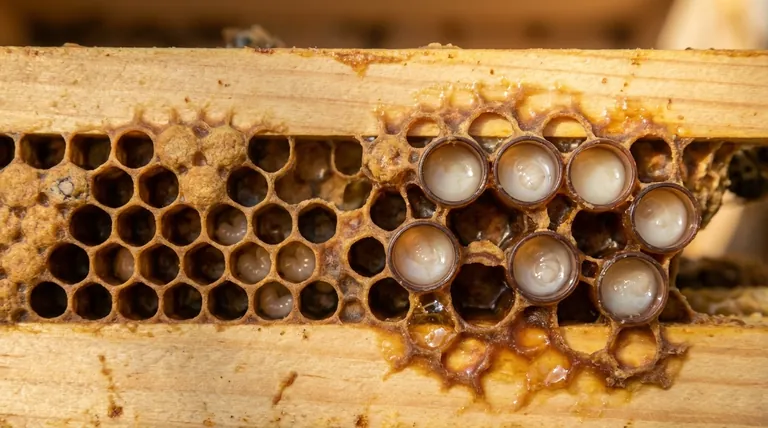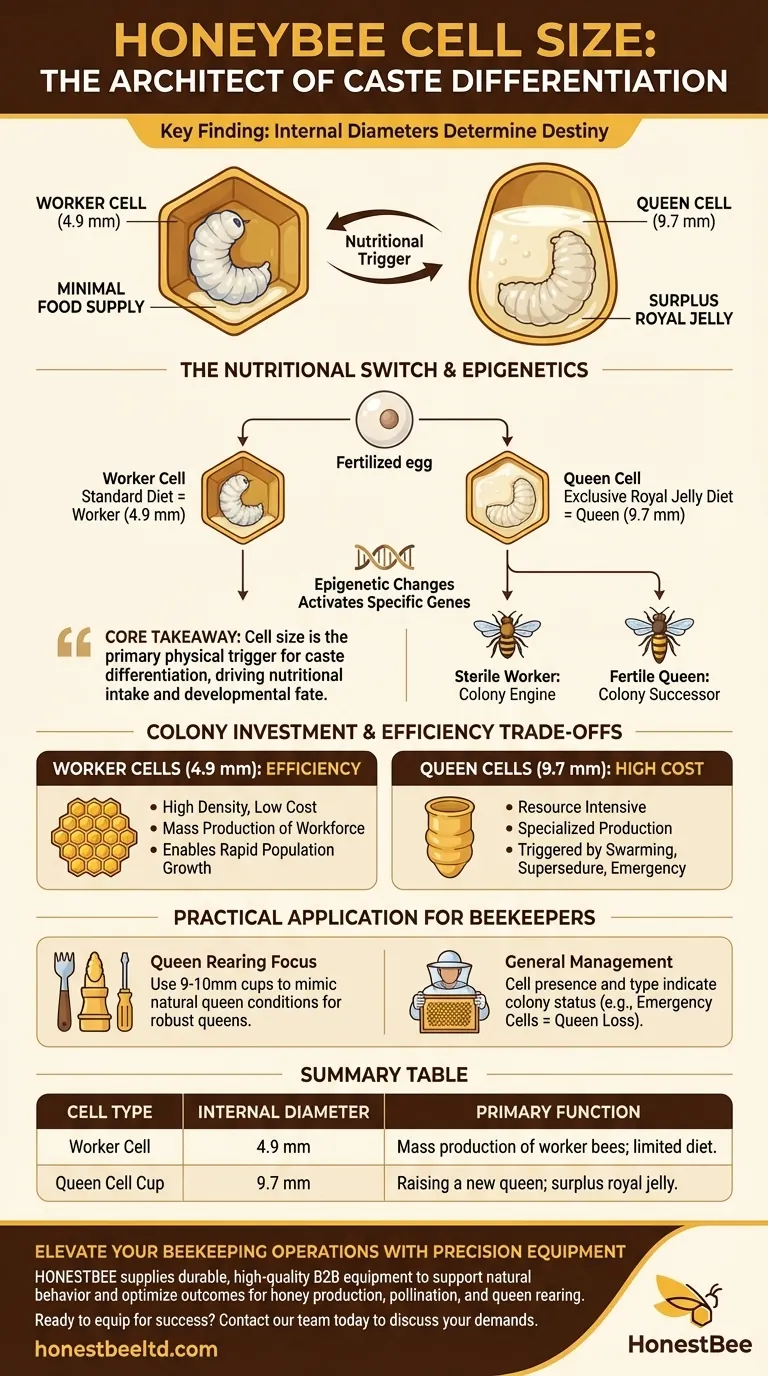In the referenced study, the worker cell cups had an internal diameter of 4.9 mm, while the queen cell cups had an internal diameter of 9.7 mm. This significant size difference is not arbitrary; it is a fundamental architectural choice by the honeybee colony that dictates the developmental fate of the larvae within.
The core takeaway is that cell size is a primary physical trigger for caste differentiation in honeybees. The larger diameter of a queen cell allows for a surplus of specific food, which is the ultimate driver in developing a larva into a queen instead of a worker.

The Role of Cell Size in Bee Development
The dimensions of 4.9 mm and 9.7 mm represent two distinct developmental pathways for a honeybee colony. One is designed for mass production of the workforce, and the other is for the specialized creation of royalty.
Worker Cells: The Engine of the Colony
The smaller 4.9 mm worker cell is a model of efficiency. Its size is precisely calibrated to raise the thousands of female worker bees that form the backbone of the hive.
This restricted space ensures the larva receives a standard, limited diet after the first few days. This nutritional constraint is a key factor that prevents it from developing into a queen.
Queen Cells: Engineering a Successor
The much larger 9.7 mm queen cell cup is built for a singular purpose: to raise a new queen. These cells are typically oriented vertically and are much larger to accommodate both a bigger larva and a massive food supply.
The sheer volume of this cell allows nurse bees to deposit a large surplus of royal jelly, the protein-rich substance that is exclusively fed to queen larvae throughout their development.
From Larva to Caste: The Nutritional Switch
Fundamentally, any fertilized egg can become either a worker or a queen. The difference is not genetic, but epigenetic, triggered entirely by nutrition.
The larger space of the queen cell ensures the larva is constantly bathed in royal jelly. This specific diet activates different genes, leading to the development of ovaries and the distinct anatomy of a queen. A larva in a smaller worker cell is weaned off this exclusive diet, steering its development toward becoming a worker.
Understanding the Trade-offs: Colony Investment
A honeybee colony operates on a strict energy budget. The choice to build a small worker cell or a large queen cell reflects a calculated investment with different returns.
The High Cost of Raising a Queen
Creating a queen is an resource-intensive process for the colony. It requires building a specialized, large cell and dedicating a significant amount of nutrient-rich royal jelly.
Because of this cost, colonies only initiate queen cells under specific conditions, such as swarming (reproduction of the colony), supersedure (replacing a failing queen), or an emergency (the sudden loss of a queen).
The Efficiency of Worker Production
The compact, hexagonal design of worker brood comb is a marvel of biological engineering. The 4.9 mm cell size allows for the highest density of new bees with the lowest possible resource cost per individual.
This production-line efficiency is what enables a colony to rapidly build its population to forage, defend the hive, and care for the next generation.
How to Apply This Knowledge
Understanding these dimensions is critical for any beekeeper aiming to work in partnership with their colonies. It moves beyond simple observation into a deeper comprehension of the bees' intent.
- If your primary focus is queen rearing: Use queen cups with an internal diameter of 9-10 mm to mimic the natural conditions that signal to the bees to raise a well-fed, robust queen.
- If your primary focus is general hive management: The presence and type of cells are your best indicator of the colony's status. Seeing emergency queen cells on the face of a frame is a clear signal that the hive has lost its queen and is trying to replace her.
By recognizing the significance of these simple measurements, you can better interpret the colony's behavior and support its success.
Summary Table:
| Cell Type | Internal Diameter | Primary Function |
|---|---|---|
| Worker Cell | 4.9 mm | Mass production of female worker bees with a standard, limited diet. |
| Queen Cell Cup | 9.7 mm | Raising a new queen, allowing for a surplus of royal jelly. |
Elevate Your Beekeeping Operations with Precision Equipment
Understanding the critical role of cell size is just the beginning. For commercial apiaries and distributors, using the right equipment is fundamental to managing colony health and productivity effectively.
HONESTBEE supplies the durable, high-quality beekeeping supplies and equipment you need to support natural bee behavior and optimize your outcomes. Whether you're focused on maximizing honey production, managing large-scale pollination services, or rearing high-quality queens, our wholesale-focused operations are designed to meet your demands.
Ready to equip your operation for success? Contact our team today to discuss your specific needs and discover how our products can contribute to your bottom line.
Visual Guide

Related Products
- Brown Nicot Queen Cell Cups for Breeding Queen Bees Beekeeping
- JZBZ Push-In Queen Cell Cups for Beekeeping
- JZBZ Type Wide Base Plastic Queen Cell Cups for Base Mounting and Queen Rearing
- Clear Black Plain Polystyrene Queen Bee Grafting Cell Cups No Lug for Bee Queen Cup
- JZBZ Langstroth Queen Rearing Frame for Beekeeping
People Also Ask
- What are the ideal conditions for raising good queen cells? Achieve Robust Queens with Strong Cell-Builder Colonies
- How does Queen Rearing with JZBZ work? A Reliable System for Consistent Queen Production
- What is the advantage of the Nicot Cupkit system? Secure Your Queen Rearing Success with Batch Protection
- What are the signs that a queen cell is about to emerge? Master the Critical Timing for Hive Success
- Why is it important to select a healthy larva less than 24 hours old for queen rearing? Maximize Queen Quality and Colony Strength















